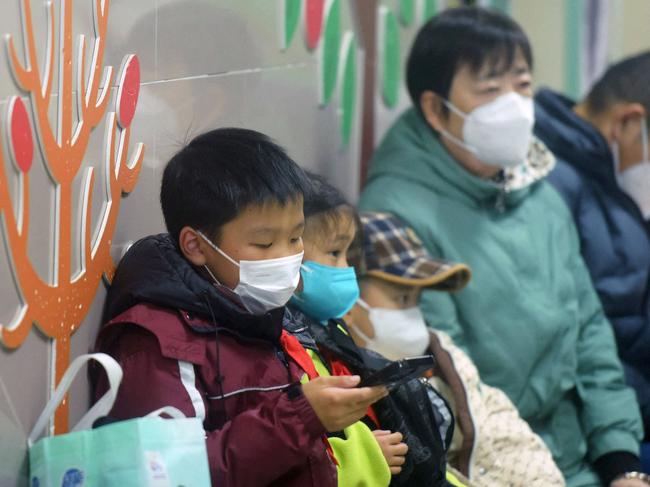HMPV outbreak in China: What Aussies need to know
As China experiences a surge of the infectious respiratory virus HMPV, here’s everything you need to know about it.
World
Don't miss out on the headlines from World. Followed categories will be added to My News.
A respiratory virus wreaking havoc in China is “quite common” in Australia, reveals Health and Aged Care Minister Mark Butler.
Nevertheless, the Australian government is closely monitoring the situation in China, which is experiencing a surge in infections and sparking concerns about an outbreak.
The virus, identified as human metapneumovirus (HMPV), has seen cases spiking across northern Chinese provinces, particularly affecting children and the elderly.
The outbreak comes five years after the outbreak of the Covid-19 pandemic.

“This type of respiratory illness is quite common here in Australia and it has been for a long time,” Mr Butler said.
“In 2024, as I understand it, about 8 or 9 per cent of recorded respiratory illnesses presenting to general practice was that type of illness. It ranked fifth in all of the usual respiratory illnesses that some people would be familiar with here in Australia.
“We’re monitoring the situation in China (and) I’m asking to be kept up to date by my department. But this is something that we’re pretty familiar with.”
HMPV is known to spread via droplets, direct contact, and possibly airborne particles.

Health authorities have put emergency measures in place to monitor the spread, but the Chinese government has downplayed the issue as an annual winter occurrence.
China’s foreign ministry spokesperson Mao Ning said: “Respiratory infections tend to peak during the winter season.
“The diseases appear to be less severe and spread with a smaller scale compared to the previous year,” she said.
The World Health Organisation has not deemed the virus as a global health emergency, but the rise in cases has prompted authorities to track and monitor the cases.
Hong Kong has reported several cases of HMPV.
Indian authorities said that the situation was under control, and that the health ministry was actively monitoring the spread of respiratory illnesses.
HMPV: WHAT YOU NEED TO KNOW
WHAT IS HMPV?
The flu-like human metapneumovirus (HMPV) is a virus that can lead to a mild upper respiratory tract infection for most people.
First identified in the Netherlands in 2001, it is practically indistinguishable from flu and usually only causes mild illness similar to a cold.
Symptoms include cough, fever, headache, nasal congestion and shortness of breath.
Like many respiratory infections, HMPV is most active during late winter and spring, possibly because viruses survive better in the cold and they pass more easily from one person to another as people stay indoors more often.
HMPV typically circulates in the Northern Hemisphere in winter, and China’s CDC data shows there have also been rises in a number of other common respiratory infections, including the seasonal flu and respiratory syncytial virus (RSV).
IS IT LIKE COVID-19?
HMPV is not like Covid-19 and experts say fears of a pandemic are overblown.
Pandemics are typically caused by novel pathogens, which is not the case for HMPV.
Covid-19 was new in humans and arose from a spill-over from animals and spread to pandemic levels because there was no prior exposures or protective immunity in the community.
HMPV, however, has been globally present for decades, meaning people across the world have some degree of existing immunity due to previous exposure.
HOW DOES IT SPREAD?
HMPV spreads from person to person in a similar way as some other respiratory viruses – through direct contact between people or when someone touches surfaces contaminated with it
The virus is present in an infected person’s mucus and saliva and spread through droplets from coughing or sneezing and through touch.
People should take necessary precautions such as getting PCR tests to identify viruses, staying home if battling an infection, wearing a mask in public, covering your nose and mouth with a tissue – or elbow— when coughing or sneezing; washing your hands regularly; and avoid sharing cups, glasses and cutlery with people who are sick.

WHO’S MOST AT RISK?
The very young, including children under two, are most vulnerable to the virus, along with those with weakened immune systems,
It’s estimated that about 10-12 per cent of respiratory illnesses in children are caused by HMPV and most people will get HMPV at some point before age five.
Reinfections can occur throughout life.
IS IT IN AUSTRALIA YET?
Experts say the virus is not unfamiliar to Australians and it’s unlikely to warrant panic.
It was circulating in Australia in October last year and there was an outbreak of HMPV cases in New South Wales in 2023.
HOW IS IT TREATED? IS THERE A VACCINE?
Health care providers can test for HMPV but there is no vaccine, and there is no specific antiviral therapy to treat infections. Resting at home and staying hydrated can help with symptoms, as well as some over-the-counter medications.
Mild cases of HMPV usually last a few days to a week, and many people recover by themselves within two to five days.
However, researchers in Australia are working on a vaccine, with the University of the Sunshine Coast running a clinical trial.
More Coverage
Originally published as HMPV outbreak in China: What Aussies need to know
Read related topics:Explainers





